4/1/2019
The Latest Information on a Hitchhiking Pest
Allison Westbrook
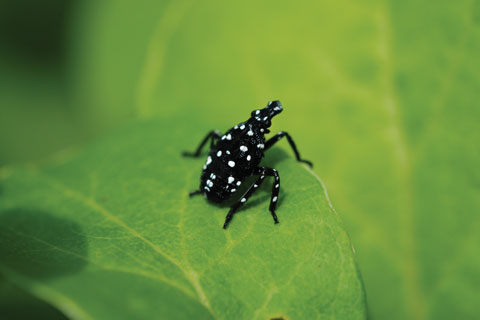
The Spotted Lanternfly represents a new pest challenge to those in the horticulture industry due to its wide host range and potential for damage. In our previous coverage, we had preliminary information about this pest, as it had just been detected and not much was known about it. But the first, and arguably most important, update is that the geographic range has increased.
Pictured left: Early nymphal stage of Spotted Lanternfly.
Pictured right: Late nymphal stage of Spotted Lanternfly.
Photos courtesy of the Pennsylvania Department of Agriculture.
Southeast Pennsylvania is still the area with the largest population and there are 13 Pennsylvania counties under quarantine (this hasn’t changed). However, the population has spread further east to New Jersey, (with three counties under quarantine), south to Delaware (a known population in New Castle County with some zip co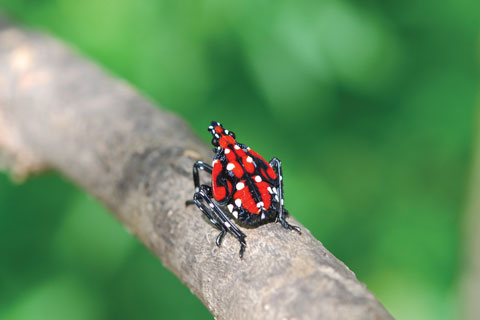 des under quarantine) and a satellite population (meaning one that’s not connected to the main starter population in Pennsylvania) down in Winchester, Virginia. There have also been detections in New York, Connecticut, Massachusetts and Maryland. These however aren’t established populations—just areas where someone has detected a dead Spotted Lanternfly in a shipment or vehicle. So if you’re in these areas, be vigilant.
des under quarantine) and a satellite population (meaning one that’s not connected to the main starter population in Pennsylvania) down in Winchester, Virginia. There have also been detections in New York, Connecticut, Massachusetts and Maryland. These however aren’t established populations—just areas where someone has detected a dead Spotted Lanternfly in a shipment or vehicle. So if you’re in these areas, be vigilant.
Hitching a ride
Heather Leach, Spotted Lanternfly Extension Associate in the Department of Entomology at Penn State, says that it could have spread to these areas via shipments from the quarantine area. As there are railroads that run between those areas and also a main highway, egg masses could have been laid on the side of a train.
“It’s a good hitchhiker and can hop a ride with humans to new places,” she says. It can also move via the thermals (hot, rising columns of air) especially on hot, sunny days—and travel a fair distance. But most of their movement is facilitated by humans, as they’re strong hoppers, but not necessarily strong flyers.
As far as what the quarantine entails, it means that businesses and organizations that are doing business in the PA quarantine zone are required to get a permit, which the Pennsylvania Department of Agriculture is responsible for issuing. The process to receive a permit involves taking a training course on the Penn State website and passing an exam. The training course includes information on checking all vehicles and shipments at your business for signs of Spotted Lanternfly.
There are over 70 plant hosts that it can inhabit during its life cycle, a main one being tree of heaven, and this number could increase. It’s been shown that it can go all the way from egg hatch to first instar all the way to the adult stage on eight different hosts, including the aforementioned tree of heaven, black walnut, oriental bittersweet (a butternut species), sawtooth oak, hops and tulip tree. There’s also evidence pointing to tree of heaven not being a required host—at least not throughout the insect’s entire life cycle.
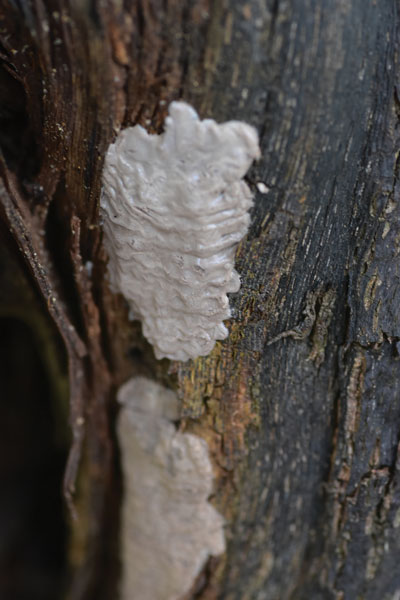 As far as insect damage, Heather says that this past year they saw some pretty significant feeding damage on tree of heaven, but they’re also seeing damage on grapes used for wine production, mostly in South-eastern Pennsylvania. They’re also seeing feeding damage on black walnut, especially saplings, as the nymphs are sucking pests and either kill saplings outright or cause drastically unhealthy looking trees.
As far as insect damage, Heather says that this past year they saw some pretty significant feeding damage on tree of heaven, but they’re also seeing damage on grapes used for wine production, mostly in South-eastern Pennsylvania. They’re also seeing feeding damage on black walnut, especially saplings, as the nymphs are sucking pests and either kill saplings outright or cause drastically unhealthy looking trees.
Pictured: Spotted Lanternfly egg masses. Photo courtesy of Erica Smyers.
As for Spotted Lanternfly vectoring disease since it’s a sucking pest, Heather said that, so far, they haven’t been able to determine any diseases associated with Spotted Lanternfly, but it’s certainly something that needs further investigation.
“With some of the ornamental trees, we have seen trees oozing, or maybe producing some sort of bacterial or fungal response, and we’re not exactly sure why that is and what’s causing that,” she explained. “It’s too early to tell at this point, but it’s certainly a potential.”
Containment & control
There are some chemical options out there, and Heather says that they just finished up some trials on both egg masses and the nymph and adult stages, to find out what works best for each life stage. It appears that so far, nymphs are a little more susceptible to insecticides than adults. She says while there appear to be a lot of insecticide options, control is difficult due to continual reinvasion.
There are five known compounds that have good knockdown activity, and in some cases, long residual activity, lasting seven to 14 days and sometimes even longer periods. In those cases, growers don’t have to go in and continually apply the insecticide; they’ll have some control for at least a week or more. These recommended compounds are dinotefuran, carbaryl, bifenthrin, zeta-cypermethrin and thiamethoxam.
As far as cultural practices, banding with sticky tape is recommended, but Heather says that they’re not really sure that will decrease the population. However, “it might reduce it locally, and it could be an option for homeowners, especially if they don’t want to use chemicals,” she said.
Another encouraged practice is mechanical removal of egg masses throughout the winter, scraping them off of vehicles, buildings, trees—wherever they’re seen. Again, this isn’t a complete solution, as egg masses can hide in all sorts of places, but every little bit of removal helps.
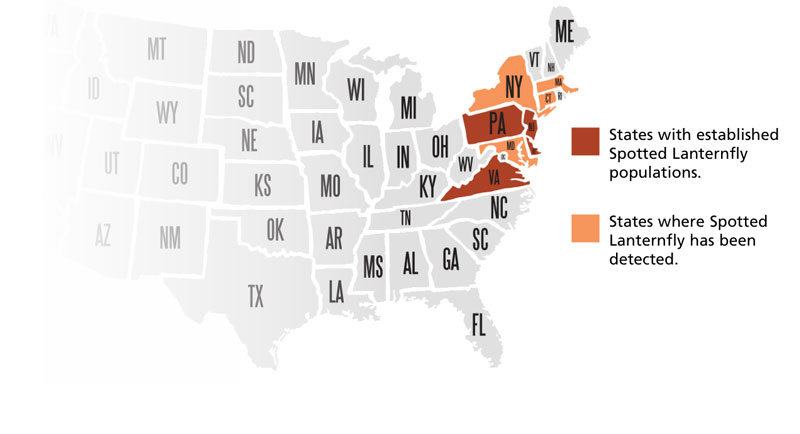 JC Chong, associate professor of entomology at Clemson University, said that while management and damage will be a huge problem in the landscape (as seen in Pennsylvania), the biggest issue for nurseries will be shipping regulations into and out of quarantine areas. Growers will likely be fined and the shipment rejected if egg masses or insects (dead or alive) are found on transported plants. Also, while it remains to be seen if Spotted Lanternfly vectors viruses, this could be a potential area of great concern to growers.
JC Chong, associate professor of entomology at Clemson University, said that while management and damage will be a huge problem in the landscape (as seen in Pennsylvania), the biggest issue for nurseries will be shipping regulations into and out of quarantine areas. Growers will likely be fined and the shipment rejected if egg masses or insects (dead or alive) are found on transported plants. Also, while it remains to be seen if Spotted Lanternfly vectors viruses, this could be a potential area of great concern to growers.
Heather says that the abundance of Spotted Lanternfly in an area is seeming to be dependent on the proximity of desired hosts and the season, e.g., what’s available and what’s actively pushing out new growth. JC agreed, saying that the best avenue for control is learning what’s likely to be fed on at what time (and for how long) and to go from there.
“We’ll see them on roses, but they’ll only be on those roses for say, a week, so it’s not warranted to spray them,” Heather said. “For the most part, we’re seeing landscape professionals and ornamentals people spraying when they see high populations of nymphs on trees and possibly treating backyard trees they want to protect.”
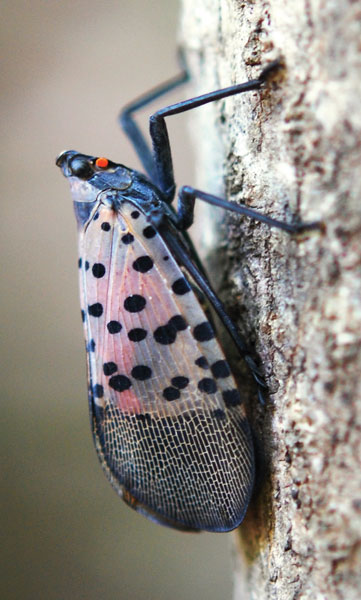 Pictured: Adult Spotted Lanternfly. Photo courtesy of the Pennsylvania Department of Agriculture.
Pictured: Adult Spotted Lanternfly. Photo courtesy of the Pennsylvania Department of Agriculture.
Heather says, with the adults, they’re starting to see a bit more predictability on what hosts they move to and when throughout the season. When they move to trees, there’s an opportunity to kill Spotted Lanternfly with systemic insecticides, which kills feeding adults. Dinotefuran and imidicloprid are recommended for this purpose.
JC said that his takeaway is that it’s not if other states will get Spotted Lanternfly, but when. It’s highly mobile, as eggs can hitchhike via cars and trains. Keep your eyes open for all stages of the insect and monitor potential hosts, such as tree of heaven or black walnut, in your landscape. And be on the look-out for symptoms, such as flagging and yellowing of branches and leaves, plants that ooze or weep and have a fermented odor, buildup of sticky fluid (honeydew) on plants and on the ground underneath infested plants, and sooty mold on infested plants.
If you do see Spotted Lanternfly, call the Penn State Extension service, or your local extension service or state department of agriculture and report it. More information can be found online at https://extension.psu.edu/spotted-lanternfly, along with management guides and identification information. GT